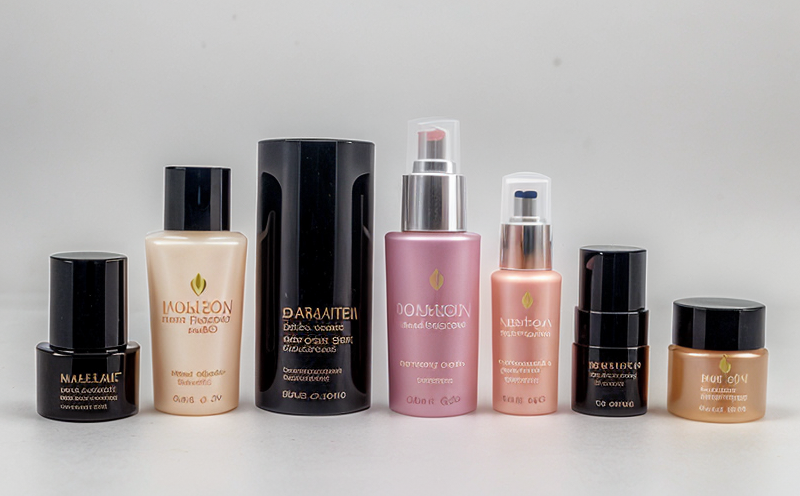Oxygen Transmission Rate Testing for Cosmetic Packaging
In the highly regulated world of cosmetics, ensuring product integrity is paramount. Oxygen transmission rate (OTR) testing plays a critical role in this regard by evaluating the barrier properties of packaging materials used to contain cosmetic products. This ensures that the contents remain stable and maintain their quality over time, thus protecting consumers from potential hazards.
The OTR test measures how much oxygen can permeate through the material over a given period under specified conditions. For cosmetics, this is crucial because oxygen can catalyze various chemical reactions within the product, leading to spoilage or altered efficacy. By conducting these tests, manufacturers can select packaging materials that provide an effective barrier against atmospheric oxygen, thereby extending shelf life and maintaining product quality.
The test itself involves placing a sample of the packaging material between two chambers—each containing different atmospheres. One chamber is filled with air containing a known concentration of oxygen, while the other is under vacuum or inert gas conditions. Over time, any oxygen that diffuses through the material moves from the high-concentration side to the low-concentration side.
The rate at which this occurs provides valuable information about the packaging's ability to prevent oxidation and maintain product integrity. This knowledge is essential for formulators who need to balance aesthetics with functionality, ensuring that their products remain safe and effective until the expiration date.
OTR testing is particularly important in the cosmetics sector because many active ingredients are sensitive to oxygen. For instance, vitamin C, which is commonly found in serums and moisturizers, can degrade rapidly when exposed to air due to its oxidation properties. Similarly, antioxidants like tocopherol (vitamin E) may become less effective if they come into contact with oxygen during storage or use.
By implementing OTR testing early in the development process, cosmetic companies can identify potential issues before launching a product onto the market. This proactive approach helps to avoid costly recalls and enhances consumer trust by ensuring that products meet regulatory standards and perform as expected.
- Environmental and Sustainability Contributions:
- Reducing waste through effective packaging design
- Minimizing material usage by optimizing barrier properties
- Promoting the use of renewable resources in packaging materials
- Increasing recyclability and biodegradability of packaging components
The test also aids in compliance with international standards such as ISO 15105-2, which provides guidelines for determining OTR values. Adhering to these standards ensures that the packaging meets both regional and global regulatory requirements, thereby facilitating easier market entry into various countries.
For quality managers and R&D engineers working in this field, understanding the intricacies of OTR testing is crucial. It allows them to make informed decisions about material selection and process optimization. In addition, it supports broader sustainability goals by helping to create more efficient and eco-friendly packaging solutions.
Scope and Methodology
The scope of oxygen transmission rate (OTR) testing for cosmetic packaging encompasses several key areas:
- Evaluation of barrier properties against oxygen permeation
- Detection of potential degradation in active ingredients due to oxidation
- Assessment of shelf life and overall product stability
- Ensuring compliance with international standards such as ISO 15105-2
The methodology for conducting OTR tests involves several steps:
- Selecting appropriate test specimens that represent the packaging material to be evaluated
- Preparing the specimens according to specific guidelines provided by the standard being followed (e.g., ISO 15105-2)
- Placing the prepared specimen between two chambers with controlled atmospheres
- Monitoring the rate of oxygen permeation over a defined time period using specialized equipment
- Analyzing the data collected to determine the OTR value and interpret its implications for packaging design and formulation optimization.
The accuracy and reliability of these tests depend heavily on proper specimen preparation, adherence to standard operating procedures (SOPs), and regular calibration of testing instruments. Ensuring these factors align with industry best practices enhances confidence in the results obtained from OTR testing.
It's important to note that while ISO 15105-2 provides general guidance on conducting OTR tests, specific nuances may vary depending on the type of cosmetic product being evaluated and the intended use of the packaging. Therefore, it is advisable for laboratories performing these tests to stay updated with any relevant updates or amendments to international standards.
Quality and Reliability Assurance
Ensuring high-quality and reliable results from OTR testing requires a robust quality management system (QMS). This includes strict adherence to standard operating procedures (SOPs), regular calibration of equipment, and ongoing training for personnel involved in conducting the tests.
The QMS should encompass several critical elements:
- Calibration: Regularly calibrate all instruments used in OTR testing to ensure accurate measurements. This includes thermocouples, pressure sensors, and any other components that affect test results.
- Data Management: Implement a robust system for recording and managing data from each test run. This helps maintain traceability and allows for easy retrieval of historical data if needed.
- Personnel Training: Provide ongoing training to ensure all personnel involved in OTR testing are familiar with the latest techniques and best practices.
- Equipment Maintenance: Regularly service and maintain equipment to prevent malfunctions that could compromise test results.
In addition to these internal controls, third-party audits can further enhance trustworthiness. These audits should cover not only technical aspects but also organizational processes and culture. They provide an independent assessment of the laboratory's capabilities and ensure compliance with relevant regulations and standards.
By maintaining a strong QMS and committing to continuous improvement, laboratories can consistently deliver accurate and reliable OTR test results. This builds confidence among clients and stakeholders while fostering trust within the industry.





